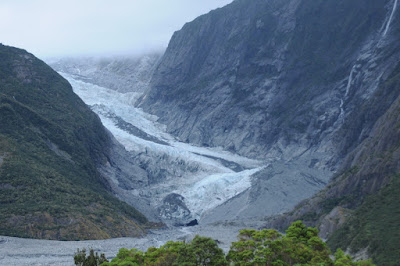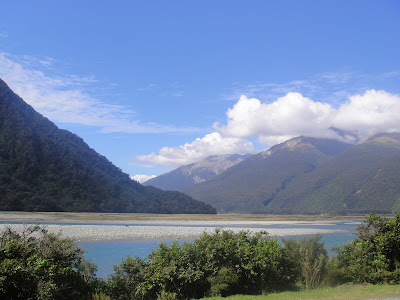We bid farewell to Kerry-Jayne on March 8, and began our return from the South Island's wild west to its more settled east via the southern route to the Fox and Franz Josef Glaciers. As we drove south we were treated to more of the magnificent seascapes that fringe this side of the island.
The largest of New Zealand's three gulls is the Kelp Gull (Larus dominicanus). It is also the most widespread - Kelp Gulls are pretty much circumpolar in the south temperate zone, besides straying fairly frequently into the north.
At Okarito We had planned to make an overnight stop to join a kiwi-spotting excursion, but found the trip fully booked and decided, instead, to continue on. First, though, we spent some time on this attractive little boardwalk in search of another New Zealand specialty, the Fernbird (Bowdleria punctata). We did not find it, though I had a splendid look at one of these shy creatures shortly afterwards in a nearby shrubby field (no photo, alas!).
We did, however, see a pair of one of New Zealand's relatively few odonates, the redcoat damselfly (Xanthocnemis zealandica), getting ready to mate.
In the still waters beneath our feet we could see a number of small fishes, almost certainly members of the Galaxiidae. The galaxiids are an interesting bunch. New Zealand, like many other oceanic island groups, has no primary freshwater fishes - that is, members of groups that evolved in fresh water. Instead, its freshwater fishes are colonists from the sea. Nonetheless, galaxiids are more than simply marine fishes that happened to swim upstream. They have been on New Zealand for a long time, and have evolved into a number of endemic species.
For most New Zealanders, though, galaxiids are chiefly of interest as whitebait, a seasonal local delicacy.
In the interest of gastronomic zoogeography, and it being the season, we deided to give whitebait a try. Apparently the traditional method is to fry them up into a sort of omelette. Our verdict: not bad, if you are in the mood for an omelette's worth of little fish, but nothing special. Galaxiids are, at least to me, more interesting alive than fried.
After Okarito the road turns away to the coast, joining the inland highway that runs south past two famous glaciers that flow down the western slope of the Southern Alps. The more northerly, and the first we reached (after an overnight stop), is the Franz Josef Glacier.
After Okarito the road turns away to the coast, joining the inland highway that runs south past two famous glaciers that flow down the western slope of the Southern Alps. The more northerly, and the first we reached (after an overnight stop), is the Franz Josef Glacier.
Like all too many glaciers around the world, Franz Josef is in retreat - one of the clearer marks of global climate change. As it melts back from its terminal moraine - the mound of debris that marks it's furthest advance - it leaves behind piles of gravel that the ice had ground away and carried downslope as it moved forward.
Getting too close to the edge of a glacier is not a good idea, as the signs clearly warned us. A snow-covered deep crevasse can make a deadly trap - not to menton the hazards of falling ice, tumbling rocks and flash floods.
Nonetheless, we were able to follow the trail to the glacier for some distance, in search of a closer look. Here is the fractured face of the glacier, from our closest point of approach.
Nonetheless, we were able to follow the trail to the glacier for some distance, in search of a closer look. Here is the fractured face of the glacier, from our closest point of approach.
The broken face of the ice reveals its layers of debris, like strata in sedimentary rock but distorted by the movement of the ice.
Below the glacier the rocks are stained with crusts of pinkish and rust-coloured lichens, interspersed with clumps of other species.
The green colour of this erratic boulder, carried downslope by the ice, is geological rather than botanical. Maori greenstone, a type of nephrite jade, is a prized gemstone in the South Island, and this may be a particularly large chunk of one of its varieties.
South of Franz Josef is Fox Glacier, the second easily-visited glacier on the southern route. We spent less time there, but found it spectacular all the same.
Our highway took us over the Haast Pass and past the beautiful scenery around Lake Wanaka, where we stopped for a final taste of the west before heading on to the east coast and our next destination.
While I poked about in the bushes in search of bird life, Eileen whiled away the time searching for attractive pebbles along the lakeshore.
Here is proof positive, if the scenery hasn't convinced you, that these photographs were taken in New Zealand. Also, I'm afraid, the closest we got to a wild kiwi - at least on this trip!


































































